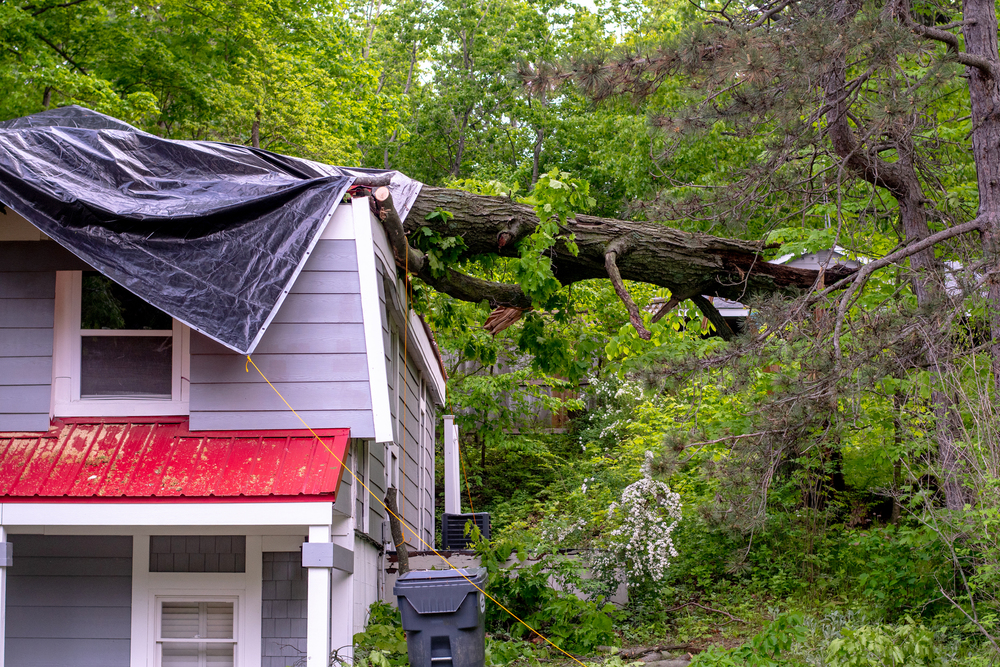Tree Damage to Roof: When Does Debris Removal Sublimit Apply?

By: Big “I” Virtual University Faculty
After a windstorm, trees fell on an insured’s roof. The homeowner’s insurance carrier is limiting payment to remove the trees from the damaged roof to the $1,000 sublimit under Section 1—Additional Property Coverages for Debris Removal. However, the other homeowners carriers the agency works with, which utilize the same HG 3 07-18 form, consider the cost of removing the tree or trees and getting them on the ground part of the loss to the insured home. They do not utilize the debris removal limit until the trees are on the ground and off the insured structure.
Q: Which interpretation is correct? At what point in the process does the debris removal sublimit apply to trees that fall on a roof?
Response 1: When a tree or limb falls on the structure and damages it, the damage is a covered loss. Further, if the tree or limb blocks access, it must be removed. That removal—called “lift and drop”—is part of the expense to repair the structure. No debris removal coverage is needed.
Once it is dropped on the ground, it needs to be cut up and hauled away. That’s where the debris removal coverage—in this case, $1,000—comes in.
It doesn’t matter what type of policy it is, from homeowners to dwelling property or commercial property. The concept is the same. Removal of the offending tree or limb to access the damage is included in the cost of repairs. Each of those policies may or may not offer some limited debris removal, but that is not needed for the cost of accessing the damaged area.
Response 2: This question has been litigated and the proper approach is to not apply the debris removal limit to the cost of removing the tree from the home or damaged property. The cost to remove the tree from the home is a necessary expense to remove the tree from the home. It’s also an expense compensable as reasonable repairs under Section 1—Additional Property Coverages because it’s an expense necessary to protect the home against further damage.
When I had an adjuster try to apply the debris removal limit to the cost of removing the tree from the roof, I asked them to check on how the contract should be interpreted legally. They checked with the Property Loss Research Bureau, a legal service for insurers, and were advised that the debris removal limit for trees should not apply to the cost to remove them from the damaged property, just the cost to remove them from the residence premises.
Response 3: Technically, limiting payment to remove the trees from the damaged home is the correct method per the policy:
SECTION I – ADDITIONAL PROPERTY COVERAGES
1. Debris Removal
b. “We” will pay “your” reasonable expense, up to $1,000 for the removal from the “residence premises” of:
(1) “Your” trees felled by the peril of Windstorm or Hail or Weight of Ice, Snow or Sleet;
Provided the trees:
(1) Damage a covered structure;
The $1,000 limit is the most “we” will pay in any one loss, regardless of the number of fallen trees. No more than $500 of this limit will be paid for removal of any one tree.
The policy’s definition of “residence premises” is
17. “Residence premises” means the one- to four-family house, the townhouse, or the row house where “you” reside and which is shown in the Declarations as the “residence premises”. It includes other structures and grounds at that location.
However, if the “residence premises” is a townhouse or a row house, it includes only other structures and grounds at that location that are used or occupied solely by “your” household for residential purposes.
The term “residence premises” is the dwelling—the actual structure, house or home, not the land that goes with the dwelling. Land is not covered, according to Section 1—Property Coverages, A. Coverage A – Dwelling: “’We’ do not cover land, including land on which the dwelling is located.”
Your other insureds can consider themselves lucky that their carriers are more flexible in the interpretation of the policy language.
Also, please note that the most the carrier will pay, according to policy language, is no more than $500 per tree up to the sublimit of $1,000. Therefore, if only one tree falls and the insured receives a bill for $300, then the carrier will reimburse the insured $300.
This question was originally submitted by an agent through the Big “I” Virtual University’s (VU) Ask an Expert service, with responses curated from multiple VU faculty members. Answers to other coverage questions are available on the VU website. If you need help accessing the website, request login information.
This article is intended for general informational purposes only, and any opinions expressed are solely those of the author(s). The article is provided “as is” with no warranties or representations of any kind, and any liability is disclaimed that is in any way connected to reliance on or use of the information contained therein. The article is not intended to constitute and should not be considered legal or other professional advice, nor shall it serve as a substitute for obtaining such advice. If specific expert advice is required or desired, the services of an appropriate, competent professional, such as an attorney or accountant, should be sought.










